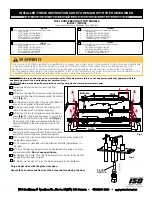
Wait until the kindling fire has turned into a good bed of embers and prior to reloading, using two
cool hand tools, carefully remove the firescreen, stack some dry firewood on top of the embers and
reinstall the firescreen using two cool hand tools. Always keep the firewood on top of the grate to
allow proper primary air flow and to prevent damage to the firescreen. The unit will burn best with 3-4
pieces of firewood (Max. 11kg/24 lbs) spaced 1 to 2 inches apart to allow combustion air to get under
and around the fuel.
2.3.4 Dangers of Creosote
When wood burns slowly or if it is not properly dry, it produces tar and other organic vapors which
combine with humidity to produce creosote. Creosote vapor condenses in the chimney left relatively
cool by the slow fire and coats the inside of the flue with a very flammable residue. When creosote
ignites, it produces a red-hot, extremely dangerous fire which can damage the whole installation and
even set fire to a home. At least once a week, it is recommended to make a brightly burning fire rather
than a lazy, smoldering fire. Not only will it keep the smoke pipe and chimney cleaner but, what is
most important, it will lessen the likelihood of chimney fires.
Caution: During the heating season, the chimney and smoke pipe need to be inspected at least twice
to determine if a creosote or soot has built-up above the safe limit of 3mm (1/8’’). If creosote or soot
accumulation exceeds 3mm (1/8’’) , immediately have the chimney and smoke pipe swept to lessen
the risk of a chimney fire.
2.3.5 Maintaining the Fire
Once the wood has been partially consumed and there is a good bed of embers, proceed to reload
the fireplace if necessary. Remove the firescreen using two cool hand tools and reload the appliance
with fresh wood. The TATIANA 997 fireplace will work best if a thick bed of hot embers is maintained
in the bottom of the firebox and 3 large or 4 medium pieces of seasoned wood are added (Max. 11kg
/24 lbs). Combustion efficiency is largely related to establishing a hot ember bed, and hot firebox
temperatures. The quicker the fireplace and chimney get up to normal operating temperatures, the
better. A small intense fire is preferred to a large smouldering fire, both to improve combustion
efficiency and to reduce the amount of creosote build-up. The best performance will be obtained by
adding fuel to a well-established ember bed to achieve a hot fire. Use a poker to make an air channel
in the embers below the wood, this will allow combustion air to flow under the wood for a more
efficient burn. This will result in less creosoting, greater efficiency and a longer lasting fire.
2.3.6 Combustion Air
As is common with open fireplaces, there is no combustion air control to set the flow of air entering
the firebox. The main source of combustion air entering the firebox is the opening in the front of the
fireplace, Therefore an Outdoor Combustion air kit must be installed to provide a sufficient amount of
combustion air in order not to deplete the space. When the fireplace is not in use, the smoke pipe
damper should be in the closed position to minimize air leakage up the chimney.
2.3.7 The Use of Composite Ecological Logs
Ecological logs made of 100% wood residues do not pose a threat to your fireplace. However, they
must be used carefully. Ecological logs typically release a much larger heat output over a short
period of time. Therefore, it is not possible to place a large quantity of such logs into the fireplace.
One 1.37Kg (3 lbs) ecological fire log gives off 7,700 btu/hr over a 3 hour burn period, therefore the
TATIANA 997 can only burn a maximum of seven (7) fire logs (Max. 9.6 kg/21 lbs) simultaneously.
WARNING: Use only ecological logs meeting the requirements of ULC/ORD-C127-M1990, Composite
Fire logs. Prior to use, refer to the fire log warning and cautions as indicated on the packaging. Do
not poke or stir ecological fire logs while they are burning. Burning more than seven (7) fire logs at
one time (max. 9.6 kg/21 lbs) can overheat and damage the TATIANA fireplace and chimney.
2.3.8 Smoking - Causes and Troubleshooting
Your fireplace has been designed and tested to provide smoke free operation. Occasionally, there
may be a small amount of smoking upon lighting the fire, until the chimney heats up but this should
not continue. If the fireplace continues to smoke it is probably for one of the following reasons:
A. Negative pressure in the house: As the fire burns, air is needed to support combustion and the
products of combustion go up the chimney. If there is an insufficient replenishment of combustion air
through leakage into the house, the fireplace will start to smoke. To temporarily create a combustion
air supply, open a window nearby, if this eliminates the smoke, the house is under negative pressure.
This can be corrected by installing an Outside Combustion Air intake. Call a contractor to install an
Outside Combustion Air intake of 100 mm (4”) in diam. with a maximum length of 4 m (13’-1/8’’). If a
longer length is needed, go to a 155mm (6”) pipe up to max. length of 6 m ( 20’) . Install the
combustion air intake high enough off the ground so that it will not become blocked by snow.
Page 12









































